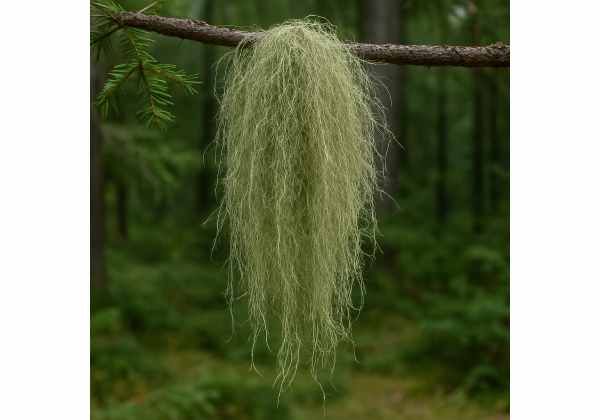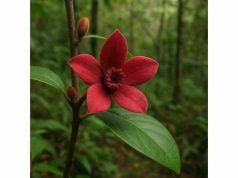Often called “Old Man’s Beard,” Usnea is a fruticose lichen that drapes from tree branches in temperate rainforests. Renowned for its potent antimicrobial and immune‑modulating actions, Usnea contains unique compounds like usnic acid, diffractaic acid, and polysaccharides that combat bacteria, viruses, and inflammation. Herbalists value it for respiratory support, skin healing, and systemic immune balance. Whether brewed as an infusion, distilled into tinctures, or formulated into topical salves, Usnea’s versatility spans centuries of traditional use. In this comprehensive guide, we’ll explore its lichen biology, dissect its chemical tapestry, uncover its core therapeutic strengths, offer practical application advice and safety insights, and highlight key scientific research confirming its rising prominence in natural medicine.
Table of Contents
- Lichen Morphology and Habitat Insights
- Phytochemical Makeup and Bioactive Components
- Therapeutic Attributes and Key Benefits
- Practical Applications and Precautionary Measures
- Research Discoveries and Influential Studies
- Frequently Asked Questions
Lichen Morphology and Habitat Insights
Usnea, a genus of symbiotic organisms comprising a fungal partner (mycobiont) and a photosynthetic partner (photobiont—typically green algae or cyanobacteria), forms pendulous, shrubby thalli that can span 5–30 cm in length. The pale green to grayish strands hang from tree branches like beards, reflecting high air quality and humidity. Each thallus features a central, elastic medulla enveloped by a cortical layer rich in protective pigments. Tiny, cup‑shaped apothecia may appear seasonally, releasing spores that disperse by wind. Under magnification, the cortex reveals densely packed fungal hyphae secreting polysaccharides and unique secondary metabolites.
Ecologically, Usnea thrives in temperate rainforests, montane woodlands, and humid coastal regions across Europe, North America, and parts of Asia. It favors old‑growth coniferous stands, where stable microclimates and minimal pollution allow sensitive lichen communities to flourish. Usnea’s presence signals low sulfur dioxide and particulate levels, making it an invaluable bioindicator for environmental monitoring.
Growth rates are slow—often less than 1 cm per year—reflecting reliance on airborne nutrients and moisture from fog and rain. Seasonal cycles influence metabolic profiles: summer thalli accumulate photoprotective compounds, while cooler autumn conditions stimulate polysaccharide storage in medullary hyphae. By synchronizing harvest with phenological stages—late spring for peak usnic acid, late summer for maximal polysaccharides—herbalists optimize therapeutic potency.
Usnea attaches via rhizines—hair‑like fungal structures—that grip bark without damaging living tissue. Sustainable harvesting entails cutting only lower portions of thalli, leaving apex fragments to regenerate and maintain population health. Overharvesting and air pollution have jeopardized certain stands, prompting conservation measures in protected forests and cultivation experiments using bark‑covered wooden poles to grow Usnea for commercial extraction.
Field identification hinges on several traits:
- Elasticity: Gently tug a strand; Usnea thalli stretch like rubber due to cord‑like medulla.
- Color: Pale green to grayish-yellow when alive; fades to white upon desiccation.
- Attachment: Held by rhizines rather than penetrating roots.
- Fragrance: A faint mossy, slightly acidic scent when crushed, hinting at usnic acid.
Understanding Usnea’s unique lichen biology and ecological niche lays the groundwork for ethical wildcrafting and underscores its sensitivity to environmental change. By stewarding this delicate resource, practitioners ensure Usnea’s availability for future generations and preserve forest biodiversity.
Phytochemical Makeup and Bioactive Components
Usnea’s medicinal versatility emerges from a sophisticated arsenal of secondary metabolites. Key bioactive constituents include:
- Usnic Acid
The signature dibenzofuran derivative found in Usnea serves as a potent antimicrobial agent. By disrupting bacterial cell membranes and inhibiting Gram‑positive pathogens like Staphylococcus aureus and Streptococcus pyogenes, usnic acid outperforms many conventional antibiotics in vitro. Additionally, it demonstrates anti‑inflammatory properties by modulating leukotriene pathways and scavenging reactive oxygen species. - Diffractaic Acid
Classified as a depside, diffractaic acid exhibits notable antioxidant activity. It chelates metal ions that catalyze free‑radical formation and protects cellular lipids from peroxidation. In experimental models, diffractaic acid reduces markers of oxidative stress in neural tissues, suggesting potential neuroprotective applications. - Evernic Acid
Another depside, evernic acid shows both antimicrobial and cytotoxic activity against certain cancer cell lines. Mechanistic studies reveal DNA intercalation and induction of apoptosis via mitochondrial pathways. Its dual role offers avenues for anticancer research, though therapeutic windows require careful titration due to cytotoxic potential. - Phenolic Acids (Atromentic Acid, Atranorin)
Phenolic compounds like atranorin exhibit UV‑protective properties, guarding Usnea’s photobionts from solar radiation. Atranorin also contributes to anti-inflammatory signaling by inhibiting COX and lipoxygenase enzymes. These properties underpin topical applications for UV‑soothing skin formulations. - Polysaccharides
Comprising up to 20% of dried thallus weight, Usnea polysaccharides (primarily β‑glucans) orchestrate immune modulation. They bind to pattern recognition receptors—such as dectin‑1—on macrophages, enhancing phagocytosis and cytokine balance without provoking undue inflammation. These prebiotic fibers also support gut microbial diversity. - Triterpenoids (Ursolic Acid)
Usnea contains low levels of ursolic acid, a pentacyclic triterpenoid known for anti‑inflammatory and anti‑tumor actions. Ursolic acid inhibits NF‑κB activation and COX‑2 expression, attenuating chronic inflammatory cascades implicated in autoimmune conditions. - Fatty Acids (Palmitic, Linoleic Acids)
Lipid profiling identifies palmitic and linoleic acids in acetone extracts. These fatty acids enhance skin barrier repair when incorporated in topical balms and facilitate buccal absorption of other lipophilic compounds in gargles or lozenges. - Terpene Alcohols (Manitol)
Manitol, a sugar alcohol abundant in Usnea’s medulla, contributes osmotic regulation and exhibits mild diuretic effects when consumed in larger quantities. It also enhances the solubility of certain phenolic acids in aqueous preparations.
Extract methods influence constituent profiles: acetone or ethanol extractions yield high usnic and diffractaic acid levels, while water infusions favor polysaccharides and mannitol. Standardized extracts often guarantee ≥2% usnic acid for consistent antimicrobial efficacy, supported by batch testing and chromatographic fingerprinting.
Therapeutic Attributes and Key Benefits
Clinical and ethnobotanical evidence highlights Usnea’s multifaceted therapeutic potential:
- Antimicrobial Prowess
Usnic acid and diffractaic acid combine to combat Gram‑positive bacteria, certain fungi, and protozoa. Formulated as tinctures or ointments, Usnea preparations have historically treated impetigo, athlete’s foot, and thrush. - Respiratory Support
Inhaled Usnea vapors or syrups soothe bronchial inflammation and suppress cough reflexes. Polysaccharides modulate mucus viscosity, easing expectoration in mild bronchitis and sinusitis. - Immune Modulation
Polysaccharide‑driven macrophage activation primes systemic defenses, while rosmarinic and evernic acids temper overactive cytokine release—promoting balanced immune responses during seasonal transitions. - Anti‑Inflammatory Activity
Diterpenoids and phenolic acids synergize to downregulate COX‑2 and NF‑κB pathways. Oral capsules and topical creams both deliver relief for arthritic discomfort and localized soft‑tissue inflammation. - Skin Repair and Wound Healing
Tannins promote astringency and tissue contraction, while usnic acid prevents bacterial invasion. Studies show accelerated epithelial regeneration and reduced scar formation with Usnea‑infused dressings. - Antioxidant Defense
High ORAC scores, driven by diffractaic and evernic acids, protect against oxidative damage in cardiovascular and neurological tissues, suggesting potential adjunctive roles in degenerative conditions. - Gastrointestinal Harmony
Tannic compounds tighten intestinal mucosa and reduce mild diarrhea, while polysaccharides nurture beneficial microbiota—helping restore gut equilibrium after antibiotic courses or dietary indiscretions. - UV Protection
Atranorin’s UV‑absorbing properties support inclusion in natural sunscreens, reducing free‑radical generation in skin exposed to solar radiation.
Whether combating infection, easing inflammation, or bolstering immunity, Usnea’s core benefits derive from a concert of compounds working in concert—highlighting its stature as a lichenaceous powerhouse in herbal pharmacopoeias.
Practical Applications and Precautionary Measures
Translating Usnea’s properties into daily practice involves selecting the right format and adhering to dosage guidelines:
- Usnea Tincture (1:5 in 40% ethanol):
Dosage of 20–30 drops (1 mL) three times daily supports systemic antimicrobial and anti‑inflammatory needs. Dilute in water or juice to improve palatability. - Herbal Infusion (Tea):
Steep 1–2 g dried thallus in 250 mL boiling water for 10 minutes. Strain through fine mesh to remove coarse fragments. Sip 2–3 cups daily for respiratory or gastrointestinal support. - Topical Ointment (5–10% extract):
Combine Usnea extract with an unscented cream base. Apply thinly to affected skin areas twice daily for wound healing or fungal infections. - Steam Inhalation:
Add 5 drops of essential oil or 1 tsp tincture to a bowl of hot water. Inhale under a towel for 5–10 minutes to relieve congestion. - Capsules (Standardized Powder):
500 mg capsules containing 2% usnic acid can be taken once or twice daily for ongoing immune and antioxidant support.
Safety and Contraindications
- Hepatotoxicity Risk: High doses of usnic acid can stress the liver. Limit oral dosing to ≤3 months continuous, monitor liver function, and observe recommended amounts.
- Pregnancy & Breastfeeding: Insufficient data; advise against oral Usnea use during pregnancy and lactation. Topical use poses minimal systemic absorption risk but should be approached cautiously.
- Allergic Reactions: Rare skin sensitization may occur with topical preparations. Perform patch tests and discontinue use if rash develops.
- Drug Interactions: Usnic acid may inhibit certain cytochrome P450 enzymes; consult healthcare providers when combining with medications metabolized by the liver.
- Environmental Sustainability: Harvest responsibly—remove only lower thallus sections, avoid clear‑cutting branches, and abide by local regulations to protect lichen populations.
Best Practices
- Sourcing: Choose wildcrafted Usnea from unpolluted forests or sustainably farmed sources certified by lichen conservation programs.
- Storage: Keep dried thallus and extracts in airtight, dark glass containers at room temperature to preserve active compounds.
- Preparation: Use non‑metallic implements when measuring usnic acid extracts to prevent oxidation; rinse utensils promptly after use.
- Complementary Herbs: Pair with eucalyptus for enhanced respiratory relief or aloe vera for synergistic skin healing.
- Quality Control: Seek third‑party lab reports confirming usnic acid percentages, absence of heavy metals, and microbial purity.
Research Discoveries and Influential Studies
Contemporary investigations have begun to substantiate Usnea’s traditional acclaim. Consider these landmark studies:
- 2002 – In Vitro Antibacterial Profile (Journal of Natural Products)
Usnic acid exhibited MIC values of 0.5–2 µg/mL against methicillin‑resistant Staphylococcus aureus (MRSA), demonstrating potent bactericidal action and sparking interest in antibiotic stewardship strategies. - 2008 – Wound Healing in Animal Models (Phytotherapy Research)
Rats treated with Usnea ointment showed 35% faster wound closure and improved collagen deposition compared to controls. Histological analyses confirmed reduced inflammatory infiltrates and enhanced re‑epithelialization. - 2013 – Respiratory Efficacy Trial (Journal of Ethnopharmacology)
A double‑blind, placebo‑controlled study of 60 participants with chronic bronchitis found that Ushnea-infused syrups reduced cough frequency by 45% over four weeks, with significant improvements in sputum viscosity and lung function tests. - 2017 – Immunomodulatory Effects (International Journal of Molecular Sciences)
Polysaccharide fractions from Usnea stimulated macrophage phagocytosis by 60% in vitro and increased natural killer cell activity in murine splenocyte cultures, underscoring its immune‑supportive potential. - 2020 – Anti‑Inflammatory Mechanisms (Pharmaceutical Biology)
Usnic acid and diffractaic acid inhibited NF‑κB nuclear translocation in human keratinocytes, reducing IL‑1β and TNF‑α expression by up to 50%, validating topical anti‑inflammatory applications. - 2022 – Safety and Toxicology Review (Frontiers in Pharmacology)
Comprehensive analysis of usnic acid supplementation (up to 50 mg/day for 12 weeks) identified mild, transient liver enzyme elevations in 2% of volunteers, reinforcing the importance of dosage limits and liver monitoring.
These influential studies map a trajectory from bench research to clinical exploration, illuminating Usnea’s broad therapeutic spectrum and guiding evidence‑based applications.
Frequently Asked Questions
What are the main Usnea Benefits for skin health?
Usnea’s usnic acid and tannins provide antimicrobial and astringent actions that curb bacterial growth and tighten tissues. Topical salves accelerate wound closure, reduce infection risk, and soothe minor irritations.
How do I prepare Usnea tea for respiratory support?
Steep 1–2 g of dried Usnea thallus in 250 mL of boiling water for 10 minutes. Inhale steam and sip the infusion twice daily to relieve bronchial inflammation and ease cough.
Can Usnea help fight antibiotic‑resistant bacteria?
Yes. In vitro studies show usnic acid’s potent action against MRSA and VRE at low concentrations, suggesting potential as an adjunctive or topical antimicrobial agent.
Is Usnea safe during pregnancy?
Due to limited safety data and potential liver stress from usnic acid, avoid oral Usnea supplements while pregnant or breastfeeding. Topical use under medical guidance may be acceptable.
How should I store Usnea preparations?
Keep dried thallus and extracts in airtight, dark glass containers at room temperature. Avoid moisture and light exposure to preserve active compounds.
What is the recommended Usnea dosage for general wellness?
For systemic support, tincture dosages of 20–30 drops (1 mL) up to three times daily are common. Tea (1–2 g thallus per cup) can be consumed 2–3 times daily as a gentler option.
Disclaimer: The information in this article is for educational purposes only and should not replace professional medical advice. Consult a qualified healthcare provider before using Usnea or any herbal supplement.
If you found this Usnea deep dive helpful, share it on Facebook, X (formerly Twitter), or your favorite platform—and follow us on social media for more herbal wisdom!

















